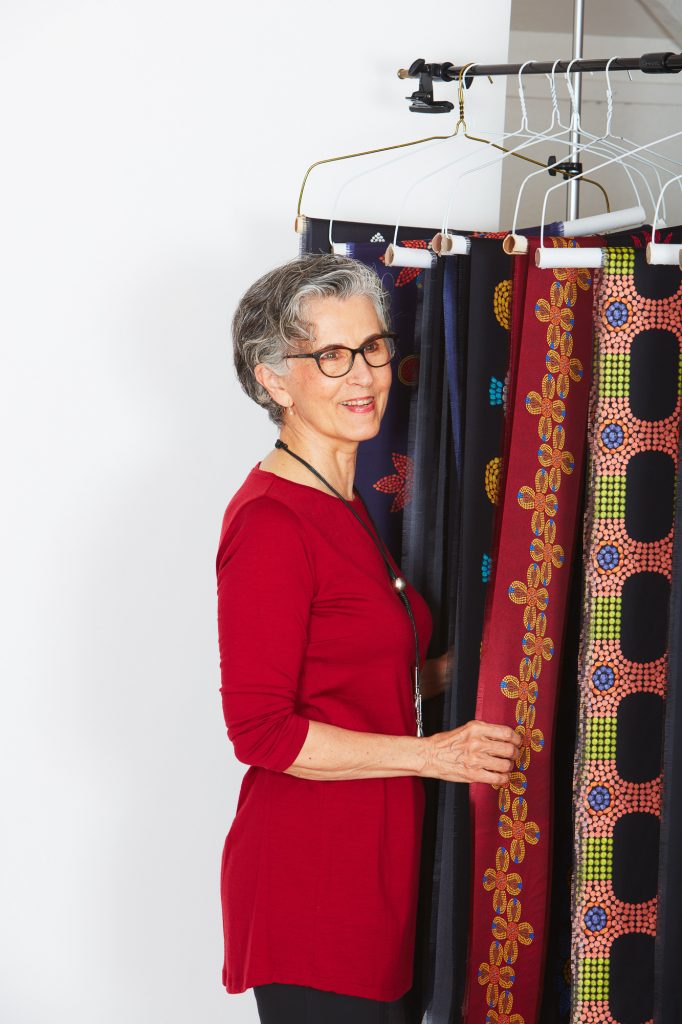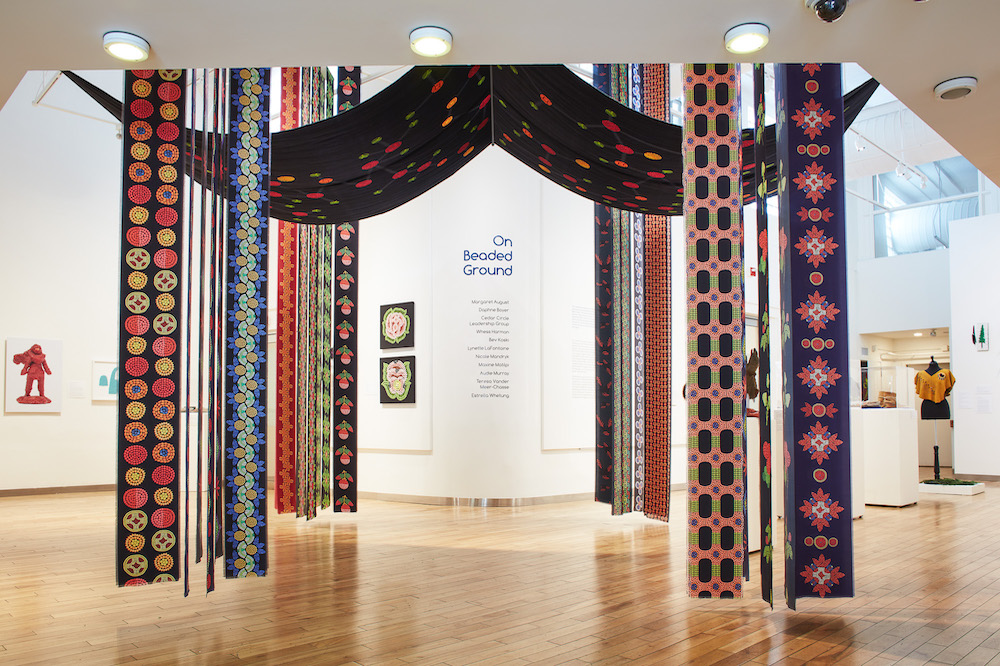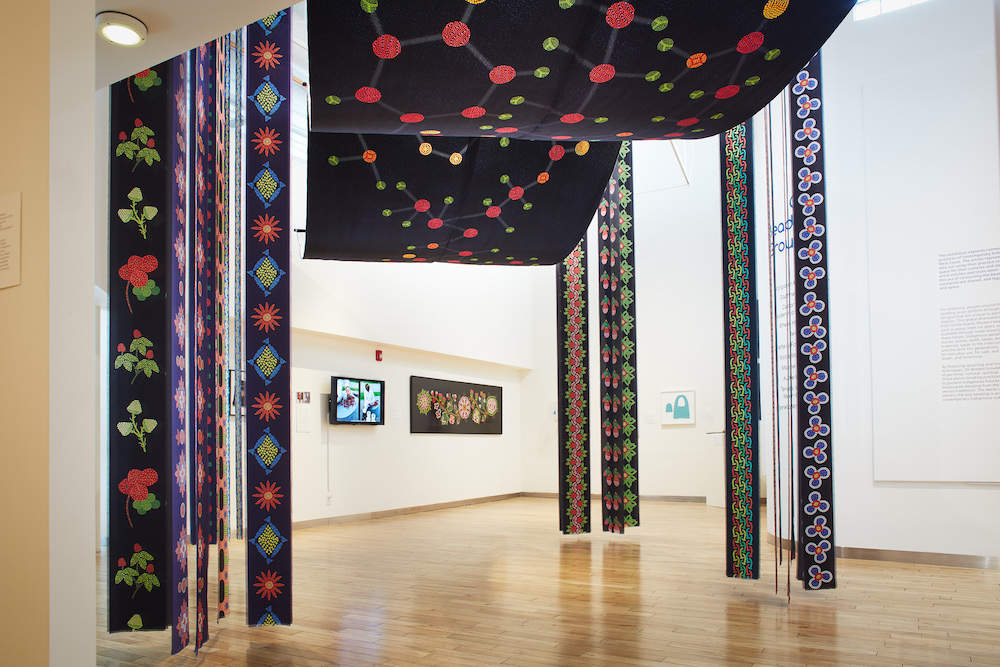[ad_1]
If there is any respite to be found from the tricky occasions that appear to encompass us, it is in art. Art that is transferring and wonderful, intriguing and awe-inspiring, and demonstrates daily life in the most earnest way. I uncover this to be correct in the perform of Daphne Boyer, a visible artist and plant scientist of Pink River Métis descent.
Applying large resolution photos of different berries and plant materials (or porcupine quills) as electronic beads—what she phone calls the “Berries to Beads” technique—Boyer produces vibrant will work that spend homage to regular handwork, celebrate her Indigenous heritage, and honour the life of her kin. The digital mother nature of her get the job done lets her to, in her phrases, “scale up, scale down, enjoy with it, and make significant tales about compact first performs.”
With ancestors who have been founding associates of the 1st Métis nation in Purple River (positioned in Manitoba), Boyer is poised to explain to the tales of her heritage. Boyer’s mom, an archivist and storyteller of Métis ancestry, retained vital paperwork and stood up to her Catholic French loved ones who had been in denial of their Métis ancestry. Describing her mom as a strong female and amazing spirit who was way ahead of her situations, Boyer provides that she “opened the doorway for [her] era to declare this aspect of our ancestry, which was really gorgeous.”

Expanding up, Boyer picked berries and bought them to regional medical professionals to pay out for Lady Information camp, and acknowledged that she preferred to be an artist. She enrolled in textile style in an artwork university but uncovered that the chemical compounds designed her really unwell. “As a considerably unhappy 2nd alternative, my spouse and I finished up restoring a substantial garden that was originally planted by [Evelyn Lambart,] the initial female movie animator at the Nationwide Film Board,” Boyer shares. They put in 11 a long time restoring that backyard, and in that environment Boyer uncovered herself confused with a need to have to specific herself. Her husband or wife developed a studio for Boyer to experiment with various supplies, to determine out what she could get the job done with. In a ski-doo match and boots, with the home windows open wide to wintry air, she determined she could do the job with acrylic paint, plant product, and a camera, which now type the foundation of her art.
With no formal training, self-doubt crept in but was right away extinguished by her supportive companion and a number of productive grant purposes. Considering that 2017, Boyer has taken on her artwork whole time, operating with a staff composed of Barry Muise, Lina Samoukova, and Etienne Capacchione. Collectively they formulated Boyer’s signature “Berries to Beads” system, but it was not without having some demo and mistake. Experimenting with how to use true berries as physical beads did not pan out so well. “That full summer season, doing the job really hard, [we] finished up with a mound of jam and massive disappointment,” says Boyer. “And I just, I was devastated. I’d invested my grant funds and then came this flash… Properly, I can do this photographically.”

In Victorian periods, when there was result in to regenerate misplaced things in art, Métis women of all ages grew to become grasp beaders of floral styles, which Métis guys wore when they travelled and delivered merchandise. Boyer claims “they would vacation among Indigenous communities, from 1 to the other,” them and their dogs in elaborately beaded garments. “It was like you could hear them coming from miles away with these pet dogs and the jingles and the color and the snow, when they would get there into the fort in a stunning display.” What have been just scatterings of seeds influenced blooming beadwork, which distribute throughout the country as cultural emblems.
Wanting to discover additional about how her relatives in shape into the history of Métis people today in the Crimson River district, Boyer fulfilled Dr. Maureen Matthews, Curator of Ethnology at the Manitoba Museum, who showed her a amount of artifacts—one currently being “Moss Bag H4-2-13,” created by an mysterious Métis-Dene artist. This artifact was a baby carrier that was adorned with a spectacular array of floral beadwork, with the Métis infinity indicator embedded in a rose on the proper of the style. Boyer was so taken by this artifact that she recreated an 8-ft-lengthy model utilizing her “Berries to Beads” system.

“It is assumed that these women of all ages had adopted the techniques, these floral patterns, but they also embedded in those people floral styles bits of their own religious beliefs, and also the resistance to colonization,” suggests Boyer. “And it is thought that this variety of thorny stem reflects in a extremely subtle way, a rejection of colonization and that the rosebuds really mirror the prospective to bloom, that matters are unfolding.”
When you glance at her function, vibrance leaps off of it—the outcome of Boyer’s grit and passionate obsession with depth. The digital berries seem as though you could get to your hand through the frame and grab a handful. Realism is a natural outcome of images, but it’s the arrangement that weaves this means into the final work. “I see each individual finished do the job as raw material for the following era of get the job done,” states Boyer. “And in that way, I’m embedding, like DNA, I’m embedding the generationality of the tales I’m telling into the operates.”

Hemoglobin is a woven tapestry of cranberry photos (or tiles), printed at distinct scales and stitched with each other. “It moves like it is breathing,” Boyer claims, as it embodies the previous breath of her mom Anita, who was a lifelong yoga practitioner and died in shavasana, the corpse pose.
Utilizing berry tiles that allude to Hemoglobin, Barn Owl and Moon celebrates Anita’s lifetime-extensive enchantment with owls, harbingers of friends. An owl glides in a sky of midnight blue berries—a unique contrast to the lively crimson hue of Hemoglobin. It suggests that Anita’s spirit now resides in the other world, from which she sends owls to explain to her family when she’ll be visiting. “We normally listen to [the owls],” Boyer says. “We say, there is Mum, [and] we’ll go to the window and pay attention.”

The amazing Birthing Tent comprises a massive velvet canopy, printed with a constellation of the oxytocin molecule, and from it wide silk ribbons of a variety of patterns rain down. The ribbons signify the toddlers that Boyer’s wonderful-grandmother Éléonore, an itinerant midwife, aided birth. The canopy, hung “like a bosom,” and ribbons pull visitors into a motherly embrace, and the oxytocin molecule formalizes our bond with other people. “My grandmother Clémence and also Éléonore, they weren’t cuddly girls. They have been solid, intense gals,” Boyer shares. “And by the time I came together, my grandmother had raised additional than 25 kids. And she was not intrigued in me. So this is a little bit of a fantasy about getting held.”
It’s been frequently recognized that time heals all wounds, but artwork has a healing power more potent than that felt by the gradual drag of the sunshine across the earth. Very last calendar year in On Beaded Floor, a group present at the University of Victoria’s Legacy Art Gallery, Boyer was shocked by the result of her get the job done. “People came into the demonstrate, and they cried,” she states. “They said, this perform is so healing.” Community engagement is an integral component of all Boyer’s demonstrates, as is doing the job with other Indigenous artists and communities.

When requested what is subsequent for her, Boyer claims, “Somebody interviewed me a short while ago and explained, ‘Well, when are you heading to convert this strategy in excess of to the up coming generation?’ I considered: Which is an assumption, that’s an ageist assumption. I obtained a large amount of miles remaining in me, and I’m likely to melt away it up!”
Boyer’s function is presently on exhibition at Fort Calgary until eventually June 26, 2022, and will journey right after to Montréal, arts interculturels (August to October 2022) and Remai Modern day in Saskatoon (September 2022 to January 2023).
Learn extra about Daphne Boyer on her internet site and Instagram.
*
Featured Impression: Rose (2019) by Daphne Boyer, picture taken by Lina Samoukova.
All photographs courtesy of Daphne Boyer.
[ad_2]
Resource hyperlink



